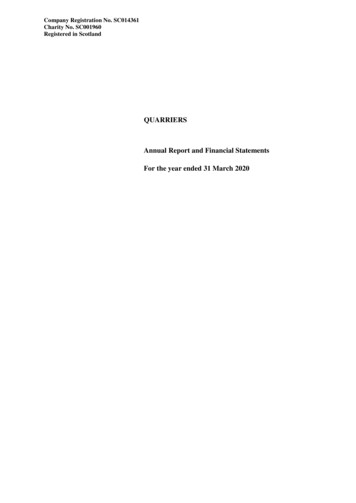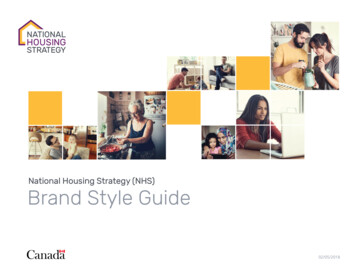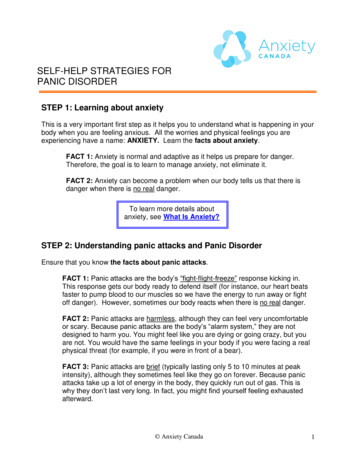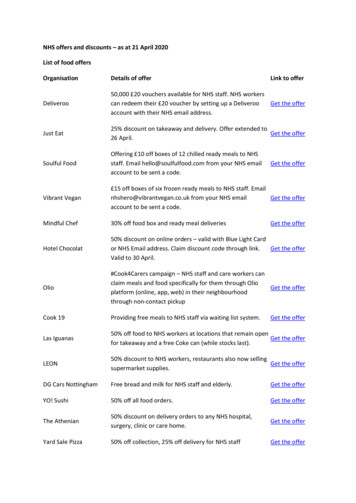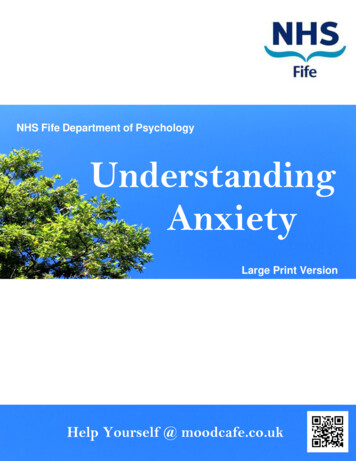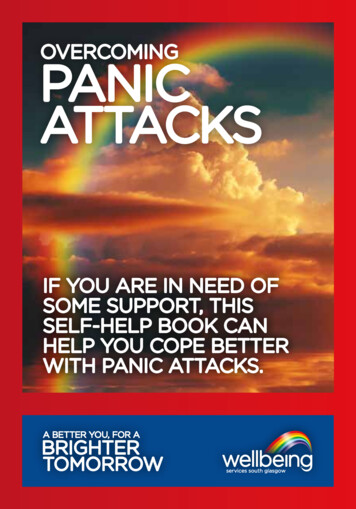
Transcription
OVERCOMINGPANICATTACKSIF YOU ARE IN NEED OFSOME SUPPORT, THISSELF-HELP BOOK CANHELP YOU COPE BETTERWITH PANIC ATTACKS.A BETTER YOU, FOR ABRIGHTERTOMORROW
PANIC ATTACKSSELF-HELP BOOKLETCONTENTSSection 1: 3-5··What is a panic attack?Section 2: 6-8··Why do panic attacks happen?Section 3: 9 - 16··Panic attacks and the bodySection 4: 17 - 23··Panic attacks and behaviourSection 5: 24 - 30··Panic attacks and thinkingSection 6: 31 - 32··ReviewSection 7: 33 - 37··Wellbeing resourcesThis self-help booklet is divided into sevensections aimed at helping you to gain abetter understanding of panic attacks. Itgives you a chance to find out what a panicattack is, how it affects you, what keeps itgoing and how to manage it.This booklet aims to help you to deal with your panic attacks usingtechniques from a well-established psychological treatment knownas Cognitive Behavioural Therapy (CBT).There are various exercises throughout this booklet to help youunderstand your panic and help you learn ways of managing it.Like any new skill, it may take a bit of time and practice before younotice any changes in the way you feel.The exercises are identified by ‘Stop & Think’. To gain the mostfrom these, it is important that you take some time to think aboutthe questions asked and complete the exercises.It may be that it takes several readings of it before you start towrite things down. That’s OK, just take your time. It is helpful toread each section thoroughly before moving on to the next.Praise yourself for every step you take.12
HOW PEOPLE DESCRIBE PANIC?SECTION 1:WHAT IS A PANIC ATTACK?John, 55 “I was sitting in my living room watching TV when I noticedpain in my chest and my heart beating faster. My hands and toes weretingling. I didn’t understand what it was at the time so I thought that Iwas having a heart attack. I couldn’t move. I had to ask my son to callan ambulance.”Julia, 35 “I was so scared of having another panic attack. I was doingIs it a panic attack?If you think you might be having panicattacks but you are unsure about someof the symptoms you experience try toanswer the questions below. Do you often experience a fast heartbeat, rapid breathing,muscle tension and sweating?Mike, 21 “There seems to be no reason for my panic. It happens out ofthe blue. When I go through an attack I get these awful sensations inmy body. I am drenched in sweat and I feel sick. I often need to get toa toilet quickly. When it happens I make sure I stay in my house for therest of the day. I am so scared that one day I will faint and there will beno one around to help me.” Do you often think you are about to faint or have a heart attack?WHAT IS A PANIC ATTACK? Do you often think something bad is going to happen?A panic attack is a sudden rush of physical and psychologicalsymptoms. It can be experienced as a period of intense anxietyaccompanied by highly uncomfortable bodily symptoms. Panic canchange what you do and how you think. Do you often think you are losing your mind when you areexperiencing those symptoms? Are you afraid of experiencing those symptoms again?If you answered ‘yes’ to one or more of those questions you might beexperiencing panic attacks. Take some time to read this booklet if: you want to know what a panic attack is you want to understand what is happening to you when you arein panic you want to know what keeps panic going you want to know what changes you can make to manageyour panic3my usual Sunday shopping in my local supermarket. The shop wasreally busy and there was no fresh air. Suddenly, I felt trapped and Icouldn’t breathe. My throat felt so tight that I thought I was going tosuffocate. My hands were shaking and my legs were like jelly. I wasterrified I would collapse and people will see me like this. Since thenI avoid going to the supermarkets if I can or I make sure my husbandalways comes with me.”PANIC AND THE BODYPanic affects your body. The most common physical symptoms ofpanic include a fast heartbeat, rapid breathing and muscle tension.The physical symptoms that accompany a panic attack can be quitefrightening if you do not understand why they appear. We will discussthe physical changes and why they occur later in this booklet.PANIC AND THE BEHAVIOURPanic attacks can change the way you behave. Perhaps you startedavoiding busy places and shopping in the city centre just in case youhave an attack there? You might have also stopped doing things youused to enjoy like reading, walking or meeting friends.4
PANIC AND THE MINDA panic attack can also affect your mind and the way you think.When you are having a panic attack you might be predictingthe worst possible scenario. You might think that what you areexperiencing means that something bad is going to happen or thatyou are losing your mind. The intensity of symptoms and unclearreason for the attacks can make you think you are out of control.SECTION 2:WHY IS IT HAPPENING?PANIC AND THE FEELINGSYou might have noticed changes in your feelings when you arehaving a panic attack. You might feel unusually anxious andhelpless. You might feel lost. You might be frustrated with the factthat it is difficult to predict when the next attack will happen.TYPES OF PANIC ATTACKSThere are three types of panic attacks: attacks that can be predicted night-time attacks out-of-the-blue attacksSometimes, panic attacks can be difficult to predict and canhappen unexpectedly. If you want to know what brings an attackon, read this booklet.HOW LONG DOES IT LAST?A panic attack is time-limited and usually lasts between 5 to 20minutes. If the attack appears to last longer than 20 minutes it islikely that you are still very anxious following the attack.Is it just me?Panic attacks are common. They are not asign of mental or physical illness. Panic canaffect anyone at any stage of their life. Infact, some surveys show that one in threepeople will experience at least one panicattack at some point in their lives. You arenot alone.56
ThreatShallow breathingWHY ME?An initial panic attack can occur for a number of reasons. Some peopleare more likely to experience panic attacks than others due to theirunique genetic make-up, background and life experiences.Many people will have their first panic attack after going through astressful period in their life such as experiencing problems at work,family breakdown or illness.It might be that going through panic attacks is not your only problem.Panic attacks are common among people who suffer from anxiety,depression, phobias or sleep problems. Those who overuse substancessuch as alcohol or drugs are also more prone to the attacks.It can be sometimes difficult to determine the exact reason behindwhat is happening to us. If you want to feel better, you might wantto focus on gaining a better understanding of what keeps your panicgoing and how to prevent or stop it. This booklet will help you with this.Thoughts“Something is wrong.”FeelingsPanickyBodyFast heartbeatActionsCalling a doctorOnce you are in the cycle of panic you might find it difficult tobreak it. Your physical sensations get worse, you feel more anxiousand you want to do something to stop it.HOW DOES IT START?Panic attacks can occur in situations you consider to be somehowthreatening. For example, you might feel anxious about going on abus if you believe that you might not cope in a busy environmentwithout an easy exit.Bodily sensations can also be threatening to you. For example, if younotice your breathing is unusually shallow you might focus on it for awhile and think “What is wrong with me?” Worrying about your shallowbreathing can make you anxious and agitated.STOP & THINKThink about the situations in which you feel panickyand anxious. Then, try to think what bodily sensations,thoughts, memories or images make you anxious.Write them down here.Thoughts, images and memories can also make you anxious.Look at the picture on the next page. Can you see that an unhelpfulevaluation of a bodily sensation can make you feel anxious andpanicky? What you think about a sensation in your body can lead to apanic attack.FALSE ALARMA panic attack can be seen as a false alarm, a sudden rush of anxietyand fear without a real physical threat. In other words, you mightfeel panicky and frightened despite the absence of real danger.78
SECTION 3:PANIC ATTACKS AND THE BODYThink about going home from work and spotting a tiger thatescaped from the zoo. Your brain automatically recognises thattigers can be dangerous and switches on the ‘’fight or flight’’response. As a result of the “fight or flight” response you go througha series of bodily changes. Your heart starts beating faster, yourbreathing becomes rapid and you sweat more. Those changeswithin your body occur to prepare you to fight or flee from the tiger.The “fight or flight” response also switches on when you experienceintense anxiety. It means that if you are in a situation that makesyou anxious or you experience bodily sensations that you findalarming the “fight or flight” response is active.Imagine you are in a meeting room with no windows and you haveto give a speech. You notice the lack of fresh air in the room andhow it affects your breathing. You start to worry that you will forgetyour speech. You get anxious about not being able to breatheproperly. You believe others will think you are a fool if you forgetwhat to say. The “fight or flight” response becomes active. You bodyprepares itself to fight with, or flee, a physical danger that does notexist. You become panicky.ThreatLack of fresh air, giving a speech“Fight or flight”If you want to understand how panicaffects your body, you need to understandwhat happens when you feel fear. Whenyou are in danger and feel fear, anautomatic biological response switches onto help you. This fear response is called the“fight or flight” and it causes a number ofchanges in your body.9Thoughts“I can’t breathe. Everyone will laugh.”BodyFast heartbeat,rapid breathingFeelingsPanickyActionsTalking quicklyThe picture above shows you how anxious thoughts can lead touncomfortable bodily sensations.10
STOP & THINKBODILY CHANGES - There are number of changes thathappen in your body when you feel panicky. Think aboutthe changes you experience and tick the right boxes.PHYSICAL SENSATIONSFAST HEARTBEATTINGLING & NUMBNESSLOOKING PALEOFTENSOMETIMESNEVERThe ‘fight or flight’ response is common to everyone and this iswhy most of us experience some physical sensations when we getangry. Let’s look at the explanation behind some of the physicalsymptoms of anger. Heart beating stronger and faster – The heart is pumping moreblood to the muscles in arms and legs which are important ifyou want to fight or flee. More blood carries more oxygen whichallows muscles to work harder. Blood pressure increases. Tingling and hot flushes - The blood supply is limited whereit is not needed e.g. in toes or fingers. This is why our skinlooks pale, feels cold and our fingers and toes experience tinglingor numbness. We might also experience hot flushes as ourbodies are working hard and our body temperature increases. Rapid and shallow breathing - Rapid breathing helps us toBREATHLESSNESSDIZZINESSFEELING SICKBLURRY VISIONDRY MOUTHSWEATINGMUSCLE TENSIONSHAKING OR TREMBLINGtake in more oxygen which helps our muscles to work harder.However, when our body is at rest and our breathing becomesrapid, we end up breathing in more oxygen than our body needs.This can cause breathlessness, a sensation of choking and evenpains or tightness in the chest. Dizziness - Rapid breathing means that less oxygen reachesyour head. While this is not dangerous, it produces unpleasantsymptoms such as dizziness and confusion. Muscle tension/headache - Muscles tense up in preparationfor fight or flight which results in feelings of tension, aches,trembling and shaking. Nausea & dry mouth – The digestive system shuts downmeaning your stomach becomes less active causing nauseaand a heavy feeling. You also produce less saliva which causes adry mouth. Sweating - Your body works hard to prepare you to attack or runaway which causes your body to heat up. Sweating helps you tocool down.STOP & THINKFear of fainting is quite common among people whoexperience panic attacks. However, it is very unlikely thatyou will faint when you have a panic attack. Faintingis caused by a drop in blood pressure. When you feelanxious, your blood pressure rises.1112
KNOW THE DIFFERENCEKEEP IN MIND “FIGHT OR FLIGHT”Sometimes people who are going through a panic attack think theyare having a heart attack. The thought of suffering from a heartattack can be very frightening and make you more anxious. This iswhy it is very important to know the difference betweenthe two conditions. Now, if you experience chest pain frequentlyand it is long lasting, see your GP. Otherwise, have a look at thetable below:You might wonder how understanding your bodily sensations canhelp you with your panic. When you experience uncomfortablephysical symptoms of anxiety you might think that something reallybad is happening to you. Once you start focusing on that thought,you are likely to notice more symptoms which might make youranxiety worse. Finally, you might get anxious about being anxious.PainPANIC ATTACKHEART ATTACKAny pain is usuallydescribed as ‘sharp’.It may or not be present.The pain tends to be feltover the heart.If present, you may havea crushing feeling inyour chest (like someonestanding on your chest).Pain is usually made worseby breathing in and outThis pain is usually felt inand pressing on the centre the centre of your chestof the chest.and may extend to the leftarm, neck and back.Pain usuallydisappears within aboutPain is not usually made5 - 10 minutes.worse by breathing or bypressing on the chest. Painis usually persistent andlasts longer than5 minutes.TinglingTingling is usually presentall over the body.Tingling, if present, isusually in the left arm.VomitingYou may feel sick butvomiting is less common.CommonBreathing Breathing tooquickly or too deeply(hyperventilation) is avery common panicresponse which comesbefore an attack.“I am experiencing bodily symptoms of anxiety. Those sensations arenormal and they are not dangerous. They will go away soon”.RELAXATIONLearning how to relax can help you to turn down the volume ofthese sensations. Two relaxation techniques can be particularlyuseful: controlled breathing and progressive muscular relaxation.CONTROLLED BREATHINGWhen we get panicky our breathing becomes rapid andshallow. We take in too much oxygen for our needs which wecall “hyperventilation”.Hyperventilation is very common and it often keeps panic going.It can also cause you a number of unpleasant sensations.To check if you hyperventilate answer the questions: Are you short of breath? Do you feel light-headedor dizzy? Is your breathing shallow? Does your breathing speed up? Do you often yawn, sigh orgulp in air?A heart attack does notcause you to breathe morequickly or too quickly.Panic does. With a heartattack, you may feel a littleshort of breath.Adapted from the World Health Organisation (WHO) Guideto Mental Health in Primary Care (2000). Royal Society ofMedicine Press.13The first step you could take to overcome your anxiety is keeping inmind the “fight or flight” response next time you feel anxious. Whenyou feel panicky again, you can say to yourself: Do you feel you are goingto faint? Do you feel chest pains?If you answered yes to one or more questions the chances are youhyperventilate. When this happens you may feel you do not haveenough air to breathe. In fact, it is the opposite - you have toomuch. Try not to take deep breaths, yawn, sigh or gulp air as thiswill only make you feel worse.You might want to learn how to calm down your breathing inorder to turn down the unpleasant sensations which you mightexperience in panic. Calm breathing involves taking slow, regularbreaths through your nose.14
Steps to calm down your breathing Sit in a comfy chair and relax as much as you can. Breathe in through your nose and count 1 2 3. Allow your breathing to slow down. Breathe out through your nose and count 1 2 3. To help you focus, imagine the numbers in your mind’s eye. Use slow normal breathing (10-12 breaths per minute). Repeat for at least 5 minutes. Practise twice daily.TIPS FOR PRACTICE If possible, breathe in through your nose and breathe outthrough your nose. If you find it too difficult, you can breathe outthrough your mouth. If you breathe out through your mouth, pucker or ‘purse’ yourlips (as if you are about to whistle). Use your belly when you breathe rather than your chest. Imagineyou have a balloon in your belly; as you breathe in, fill theballoon with air; as you breathe out, let the air go. You might find this exercise easier when lying down, but aftera while you should be able to do it in any position. Practise itmany times before you use it to turn down the symptoms ofpanic attacks.PROGRESSIVE MUSCULAR RELAXATIONA strategy that can help you to ease tension in your muscles iscalled progressive muscle relaxation. It involves tensing specificmuscles in your body for about 5 seconds and then relaxing them.Muscle relaxation can help you to lower the overall tension in yourbody which often makes your panic worse.Sit or lie down. You can work from your head to toes or toes tohead. Take your time, tense each muscle group for about 5 seconds.If you begin to notice your mind wandering, bring attention back toyour body. Practise it daily.Steps to relax your muscles Make sure you are comfortable. Make a fist with your left andright hand. Notice theDrop your shoulders.tension. Relax. Start by raising your eyebrows Squeeze the muscles in youras high as you can and holdupper and then lower back.them in that position forNotice the tension. Relax.about 5 seconds. Notice thetension. Then, release and Suck your stomach in.notice the relaxation.Notice the tension. Relax. Shut your eyes as tightly as Tighten your buttocks byyou can. Notice thepulling them together.tension. Relax.Notice the tension. Relax. Open your jaw as widely as Push your thighs againstyou can and make a grimaceeach other. Notice theon your face. Notice thetension. Relax.tension. Relax. Tense the muscles in your Now, bring your shoulders tocalves by pulling your toesyour ears. Notice thetowards you. Notice thetension. Relax.tension. Relax. Bend, first your right, then Finally, curl your toes.your left elbow tensing theNotice the tension. Relax.muscles in your arms.Notice the tension. Relax.You might want to practise the controlled breathing andprogressive muscular relaxation techniques using a relaxationtrack. Download a free relaxation audio file from our websitewww.wellbeing-glasgow.org.ukSTAND YOUR GROUNDNext time you feel the panic coming on, stand your ground anddon’t let the panic make you run away! You don’t need to run forhelp or run away from your panic. You can be in control of yourpanic using the relaxation techniques from this booklet.1516
STOP & THINKSECTION 4:PANIC ATTACKS AND BEHAVIOURImagine you were able to do things you are avoiding?How would that make you feel?Answer the questions below.How would you feel differently?When you feel anxious you act in away that helps to reduce your anxiety.Unfortunately, some of the things youmight do can be quite unhelpful.AVOIDANCEOne way to reduce your anxiety is to stay away from the situationswhich make you feel panicky. Avoiding those situations decreasesanxiety you might experience as you do not have to face up to thesituations you fear.How would you think differently about yourself?Avoiding certain situations or activities might help you in theshort-term. You might feel relieved that you decided not to goshopping on a busy Saturday afternoon. Unfortunately, if you keepavoiding situations you fear you will not have a chance to prove toyourself that anxiety symptoms are not dangerous and that, in fact,you can cope with the situations that cause you anxiety.What situations, places or activities did you start avoiding as a resultof panic attacks?What would people notice about you?Did you start avoiding: situations where you have had activities such as exercising,panic attacks in the past? situations where it might bedifficult to get help, such asplaces far from your home? situations from which it isdifficult to escape such asshopping at busy times orusing public transport?17watching scary movies,drinking coffee becausethey cause you sensationssimilar to physical symptomsof anxiety?SAFETY BEHAVIOURSAnother unhelpful way to reduce your anxiety is to rely on“safety behaviours”. Safety behaviours are behaviours that makefacing anxiety easier in the short-term. Unfortunately, they makeyou feel worse in the long run.18
FACING UP TO SITUATIONSSTOP & THINKHas your behaviour changed since you started experiencingpanic attacks? Ask a friend or relative if they noticed anychanges in your behaviour? Use the questions below tohelp you think about safety behaviours you might use.Do you: make sure you take the seatthat is nearest to the exit onthe bus? always carry your anti-anxietymedication with you? constantly seek reassurance? always leave the house withsomeone else? drink alcohol to reduceyour anxiety? take drugs to reduceyour anxiety?Safety behaviours may help you deal with the situations in theshort-term but they can be very unhelpful in the long-term. Safetybehaviours can stop you from getting better. For example, imaginethat since your first panic attack you decided always to carry yourmobile phone with you just in case you needed to call for help.You believe that to be safe you need to be able to call someone.You think you would not cope without your mobile and it worriesyou. What you might not notice is that by doing this you do notgive yourself a chance to see if you could cope without a mobile orassistance. The picture below shows you how safety behaviours cankeep the cycle of panic going.If you want to prove to yourself that you can manage your anxietyyou need to learn how to face up to some of the situations you fear.You can do this by gently confronting those situations and slowlygetting used to symptoms of anxiety.Facing what you fear is a very important step in overcoming yourpanic attacks. It will help you to build your confidence back bit bybit. The first time you try spending time in the feared situation youwill most likely experience some anxiety. Next time you enter thesame situation your anxiety should reduce. With time you will feelyou are gaining control over your panic and you will feel better.Think about the situations, places and activities you areavoiding due to fear of having a panic attack and write them downin the table below. Start from the situation, place or activity thatcauses you the least anxiety and build up to the one that causesyou the most anxiety.SITUATION/PLACE/ACTIVITYANXIETY RATING(from the lowest to highest)ThreatThe chance of another panic attackThoughts“I won’t cope if I’m by g in the house. Making sure phone is charged.If you want to take control over your panic and anxiety you need tochallenge your avoidance and safety behaviours.1920
If you want to overcome your panic you need to face up to thesituations you fear. Start from the top of your list. Choose a timeand place for you to go into that situation. Think about anythingthat might stop you and try to plan for that. Once you enter thesituation use the techniques from this booklet and stay in thesituation until your anxiety drops by half. If your anxiety does notreduce the first time, repeat the same step as many times as youneed, before moving on.MY SAFETY BEHAVIOURPLAN TO REDUCE ITTIPS FOR PRACTICE Overcoming panic takes time and practice. Plan what you wantto do in advance and leave yourself enough time to do it. Set yourself daily goals. Be specific and realistic. Accept it can be difficult at first; it will get easier.GETTING USED TO BODILY SENSATIONSDROPPING SAFETY BEHAVIOURSPeople who experience panic attacks can be anxious aboutuncomfortable bodily sensations associated with anxiety, suchas a fast heartbeat, dizziness or chest pain. If you want to be lessanxious when you experience those sensations you can try to bringon the sensations yourself. This will show you that there is no needto be afraid of those uncomfortable sensations.If you want to gain control over your panic attacks think about thesafety behaviours you have been using to help you face up to thefeared situations. Make a list starting from the behaviour easiestto reduce.The next step is gradually to reduce that behaviour until you areready to drop it. For example, if you have been carrying yourmedication with you at all times, try to leave it in the house nexttime you go to the shops. You can start by leaving your medicationfor 1 hour, then 2 hours, half a day, a day, 2 days. Or, if you havebeen using alcohol to be able to cope with your anxiety try toreduce the amount of alcohol you drink. If reducing your safetybehaviours makes you anxious, use the techniques described in thisbooklet to help you cope with your feelings.21You can bring on some of those sensations by doing exercisessuch as: running on the spot for 30 seconds to 1 minute quick, deep breathing for 30 seconds to 1 minute shaking your head from side to side for 30 seconds putting your head between your legs for 1 minute and thensitting up quickly staring at the blank wall for 2 minutesAfter you try each exercise rate your anxiety level from 0 (noanxiety) to 10 (severe anxiety). Then, make a list starting from theexercise that caused you the least anxiety and build up to the onethat caused you the most anxiety. Write them down in the tableon the next page.22
PHYSICAL EXERCISEANXIETY RATING(from the lowest to highest) Once you have made your list, you can start doing theexercises again. Start with the exercise that is the least scary.Do the exercise for long enough to experience the unpleasantsensations. Rate your anxiety once again from 1-10 with eachexercise. Repeat the exercise until your anxiety rating drops byhalf. Once you experience little or no anxiety move to the nextexercise from the list. Remember that bodily sensations are not dangerous. They arequite normal and each one of us experiences them from time totime. Do not be afraid to experience them.TIPS FOR PRACTICE You can always break each exercise into smaller steps. Forexample, quick deep breathing can last 30 seconds at first, then45, then a minute. You might need to do the exercise several times for a few daysbefore the anxiety reduces. Overcoming your panic takes timeand practice. Plan your exercises in advance and leave yourselfenough time to do them.23SECTION 5:PANIC ATTACKS AND THINKINGOur mind comes up with new thoughtsand ideas all the time, but this happens soquickly that we do not notice it. Most ofour thinking happens automatically, just likewalking or driving.We are not used to slowing our mind down and observinghow it works.Yet, how we think can have a great impact on how we feel. This iswhy it can be helpful to train yourself to notice your thoughts, asthey appear and to be more aware of how they make you feel.Thoughts that come to our mind can be: neutral e.g. “I will call my auntie today.” positive e.g. “ I dealt with that problem so well today.” negative e.g. “If I go to that party I will make a fool of myself.”Negative thoughts can make us feel low or anxious and this is whythey can also be called unhelpful thoughts. Often, we believe ourunhelpful thoughts as they seem very reasonable at the time. Theycan be very difficult to stop.24
WHAT HAPPENS TO MY THOUGHTS WHENI AM ANXIOUS?Look at the picture below illustrating how unhelpful thoughts canlead to panic and also keep it going.When you are anxious the way you think changes and youexperience more unhelpful thoughts than usual.Firstly, as a normal part of the "fight or flight" response your mindstarts scanning the environment for threats. Now, this wouldbe helpful if you were in danger, however it is not very helpfulotherwise. As a result, you may find it difficult to concentrate andyou might feel distracted.When your mind cannot find any danger in the environment itstarts focusing on your body. This is when you notice your heartpounding and your body sweating. You might start thinking thatthose uncomfortable sensations mean there is something wrongwith you.Thoughts you experience when you feel panicky often fallunder two unhelpful thinking styles: jumping to conclusionsand catastrophising.JUMPING TO CONCLUSIONSWe jump to conclusions when we make assumptions aboutwhat is happening based on little information. Take a look atsome examples: "My heart is pounding, I must be "My mind is racing, I must behaving a heart attack!" "I feel terrible, I must be gettingseriously ill."going mad."ThreatPounding heartThoughts“I might be ill. I might faint or even die.”FeelingsPanickyBodyShakingActionsLooking up symptoms on the InternetSTOP & THINKWhat do you think when you become panicky?Write it down. "I find it hard to breathe. I'm notgetting enough oxygen."CATASTROPHISINGWe catastrophise when we imagine the worst possible scenarioand we believe we will not be able to cope once it happens. Look atsome examples: "I'll definitely have a panicattack if I go shopping atthe weekend." "If I have another panic attack Iwon't be able to cope."25 "If I have a panic attackin public I'll make a foolof myself." "Next time I have a panic attackI might die."It can be difficult to know what your thoughts are when there areso many of them racing through your mind. When you are anxiousyour thoughts can become muddled up and very unclear. In fact,you might be under the impression that you think nothing at all.The key here is observation and practice. Try to stop, step back andobserve your thought
Panic attacks are common among people who suffer from anxiety, depression, phobias or sleep problems. Those who overuse substances such as alcohol or drugs are also more prone to the attacks. It can be sometimes difficult to determine the exact reason behind what is ha


